Stan Hywet Hall & Gardens

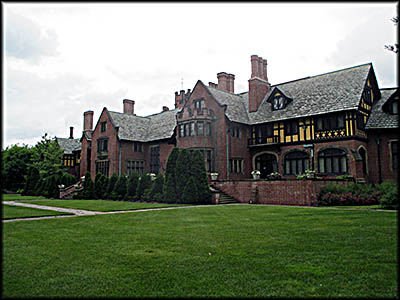
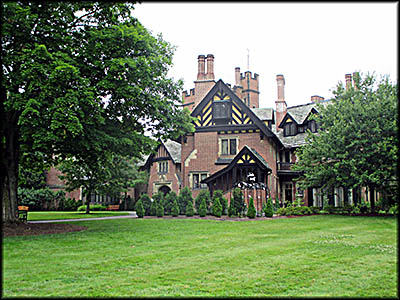
Stan Hywet House Front and Back
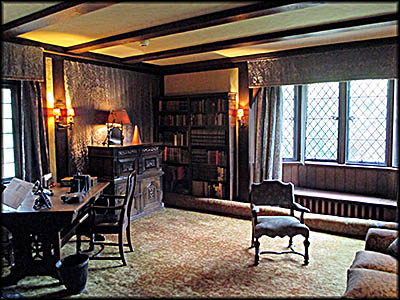
Blue Bedroom
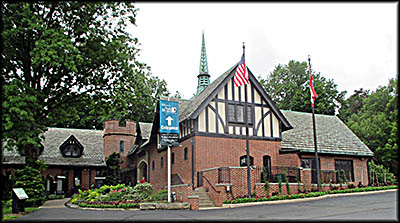
Carriage House/Museum Entrance
If you’ve ever wanted to visit an English manor house but can’t be bothered to travel to Britain, you’re in luck. In Akron, Ohio you’ll find a Tudor Revival sixty-five room mansion known as Stan Hywet Hall that comes complete with English and Japanese Gardens as well as a conservatory in which Professor Plumb was not murdered by a wrench. I’ve never been rich and won’t likely be short of marrying a wealthy heiress, so a visit here is the closest I’m ever get to seeing what it’s like to be so wealthy that I don’t know what to do with all my money.
Having a pretty good working knowledge of famous Americans rich enough to build such a place, I wracked my brain trying to remember who Stan Hywet was, my assumption being the house was named for a person. It wasn’t. An information sign said it’s an Old English word that means “Stone Quarry,” so named because there was once one on the grounds that landscape artist Warren Manning transformed into a place for outdoor recreation that included tennis courts, swimming, and, in the winter, ice skating. At the top edge of the quarry is are two teahouses underneath which is a changing room.
So who did the house belong to? That would be the Seiberling family. If that name doesn’t ring any mental bells, the company that Frank “F.A.” Seiberling and his brother, Charles “C.W.,” founded certainly will. They started Goodyear Tire and Rubber Company in 1898, which was named after the inventor of vulcanized rubber, Charles Goodyear. It was F.A. who drew the winged-foot logo that the company uses to this day. So successful was this venture that F.A. could readily afford to build and maintain his massive mansion, which was constructed between 1912 and 1915. He and his wife, Gertrude Penfield, lived in the house for forty years and in that time hosted thousands of guests, including the von Trapp family and President Howard Taft.
Having a pretty good working knowledge of famous Americans rich enough to build such a place, I wracked my brain trying to remember who Stan Hywet was, my assumption being the house was named for a person. It wasn’t. An information sign said it’s an Old English word that means “Stone Quarry,” so named because there was once one on the grounds that landscape artist Warren Manning transformed into a place for outdoor recreation that included tennis courts, swimming, and, in the winter, ice skating. At the top edge of the quarry is are two teahouses underneath which is a changing room.
So who did the house belong to? That would be the Seiberling family. If that name doesn’t ring any mental bells, the company that Frank “F.A.” Seiberling and his brother, Charles “C.W.,” founded certainly will. They started Goodyear Tire and Rubber Company in 1898, which was named after the inventor of vulcanized rubber, Charles Goodyear. It was F.A. who drew the winged-foot logo that the company uses to this day. So successful was this venture that F.A. could readily afford to build and maintain his massive mansion, which was constructed between 1912 and 1915. He and his wife, Gertrude Penfield, lived in the house for forty years and in that time hosted thousands of guests, including the von Trapp family and President Howard Taft.

F.A. married Gertrude on October 12, 1887. Gertrude was trained as a contralto opera singer and once sang at a White House state dinner for President Howard Taft. She founded a number of music groups and associations in Akron such as the choral assembly St. Cecilia Society and the Tuesday Musical Club, this last offering concerts on Tuesday afternoons with a focus on musical education. Gertrude and F.A produced seven children, all of whom lived to adulthood. (The museum’s Walk the House guide and at least one of its information signs list the number of their children as six, but the Stan Hywet website says it is seven plus it lists their names, so that’s the number I’m going with.) Their children in turn gave them twenty-two grandchildren, one of whom, Grace Wenonah, died at the age of seven and a half months. F.A. was a good family man and encouraged his adult children to stay in the house as long they liked. Gertrude and F.A., who celebrated fifty-eight anniversaries, occupied Stan Hywet for forty years.
In 1898 F.A. had an opportunity to purchase a series of empty mill buildings at the bargain price of $12,500, so he snatched them despite the fact he had no idea to what purpose they’d be put to or how he was could to pay for them. Realizing that there was a large pool of laborers who had once worked for B.F. Goodrich Tire & Rubber Company in Akron, which had been in business since 1871, he decided to establish a rubber manufacturer since he could draw a pool of experienced workers. Goodyear’s first products included bike tires, hoses, horseshoes, and car tires.
The company needed a product that would give it significant market share and to that end produced the straight side tire. This replaced the inferior clincher design, which was difficult to change without specialized tools and was prone to damage by the tire rim. The straight side tire, introduced in 1905, also allowed more room for air in its tube, helping it cushion the ride of any car using it. F.A. directed employee William Stevens to design a machine capable of mass producing tires. And while the resulting Seiberling Stevens tire building machine worked, it wasn’t until its redesign by W.C. State that it made a big difference. With the Seiberling State machine, a single worker could produce sixty tires an hour versus the five when done by hand. Even better, other companies began using it, resulting in about $200,000 a year in patent royalties.
In 1898 F.A. had an opportunity to purchase a series of empty mill buildings at the bargain price of $12,500, so he snatched them despite the fact he had no idea to what purpose they’d be put to or how he was could to pay for them. Realizing that there was a large pool of laborers who had once worked for B.F. Goodrich Tire & Rubber Company in Akron, which had been in business since 1871, he decided to establish a rubber manufacturer since he could draw a pool of experienced workers. Goodyear’s first products included bike tires, hoses, horseshoes, and car tires.
The company needed a product that would give it significant market share and to that end produced the straight side tire. This replaced the inferior clincher design, which was difficult to change without specialized tools and was prone to damage by the tire rim. The straight side tire, introduced in 1905, also allowed more room for air in its tube, helping it cushion the ride of any car using it. F.A. directed employee William Stevens to design a machine capable of mass producing tires. And while the resulting Seiberling Stevens tire building machine worked, it wasn’t until its redesign by W.C. State that it made a big difference. With the Seiberling State machine, a single worker could produce sixty tires an hour versus the five when done by hand. Even better, other companies began using it, resulting in about $200,000 a year in patent royalties.
For much of the first two decades of the twentieth century, truck tires were still made of solid rubber. In 1917, Goodyear released the pneumatic truck tire, a design that by 1918 was on its way to sending solid truck tires into the dustbin of history. Its release year coincided with the United States’ entry into World War I during which 6,200 Goodyear employees went off to fight. With a labor shortage, both Goodyear and Firestone Tire employed over 1,000 deaf men to fill the missing ranks, which helped their community overcome negative stereotypes. F.A. bought $260,000 in war bonds from his personal fortune, and directed Goodyear to purchase another $565,000.
In addition to tires, for the war effort Goodyear produced gasmasks, balloons, and rubber airplane parts. When it developed a superior gasmask design, it shared it with other rubber companies. It also fulfilled contracts for an American version of the German zeppelin. To facilitate this, it purchased 720 acres close to Fritch’s Lake. Renaming the area Wingfoot Lake, it built the infrastructure needed to produce hydrogen-based observation balloons and blimps.
In 1920 the United States slipped into a depression that lasted through 1921. During that time Goodyear had to get financing to keep afloat, a deal that resulted in F.A. leaving the company. Six months later he and his brother, C.W., started the Seiberling Rubber Company in Barberton. By this time the rubber production market was thoroughly saturated by producers and the new company struggled through the Great Depression, with C.W. sometimes dipping into his personal fortune to keep it afloat. It rebounded during World War II and survived until 1968 when Firestone bought it.
In addition to tires, for the war effort Goodyear produced gasmasks, balloons, and rubber airplane parts. When it developed a superior gasmask design, it shared it with other rubber companies. It also fulfilled contracts for an American version of the German zeppelin. To facilitate this, it purchased 720 acres close to Fritch’s Lake. Renaming the area Wingfoot Lake, it built the infrastructure needed to produce hydrogen-based observation balloons and blimps.
In 1920 the United States slipped into a depression that lasted through 1921. During that time Goodyear had to get financing to keep afloat, a deal that resulted in F.A. leaving the company. Six months later he and his brother, C.W., started the Seiberling Rubber Company in Barberton. By this time the rubber production market was thoroughly saturated by producers and the new company struggled through the Great Depression, with C.W. sometimes dipping into his personal fortune to keep it afloat. It rebounded during World War II and survived until 1968 when Firestone bought it.
During F.A.’s lifetime he had a working farm on land he owned next to his house. Originally called White Sands Farm, it was renamed to Portage Path Farm in February 1916. Here wheat and corn were grown, the former being sold to the Quaker Oat Company from 1916 to 1919. Turkeys, chickens, ducks and pheasants were raised and a peach orchard maintained. Surplus milk was sold to the Akron Pure Milk Company.
On the Stan Hywet Hall grounds proper there are quite a few outbuildings including the conservatory and carriage house. The latter now serves as the museum’s entrance and a gift shop. Before being repurposed, it once housed a garage, mechanic’s shop, horse stable, and car wash. Above it were apartments for the chauffer and other staff.
The main house contains eighteen bedrooms, twenty-three bathrooms, three elevators and twenty-three fireplaces. Since family members had better things to do with their time other than cook, clean, and garden, they employed between sixteen and twenty domestic servants and nine to twelve estate employees to perform all that drudgery work. After all, when you’ve got such diversions such as a massive indoor pool, a game room, an extensive library, and a 2,700 square foot music room, you don’t have time for much else.
The number of bathrooms and bedrooms were there in large part to accommodate guests. The main formal dining room could hold up to fifty people, though at Christmastime that wasn’t nearly enough for the extended family, so the adults and older children ate in the dining room and the younger children did so in the North Hallway or Breakfast Room. Guests were often entertained in the music room. Lining its walls and hidden from view are 2,433 pipes for the family organ, which could either be played by hand (Gertrude liked to do this) or run automatically using a music roll.
On the Stan Hywet Hall grounds proper there are quite a few outbuildings including the conservatory and carriage house. The latter now serves as the museum’s entrance and a gift shop. Before being repurposed, it once housed a garage, mechanic’s shop, horse stable, and car wash. Above it were apartments for the chauffer and other staff.
The main house contains eighteen bedrooms, twenty-three bathrooms, three elevators and twenty-three fireplaces. Since family members had better things to do with their time other than cook, clean, and garden, they employed between sixteen and twenty domestic servants and nine to twelve estate employees to perform all that drudgery work. After all, when you’ve got such diversions such as a massive indoor pool, a game room, an extensive library, and a 2,700 square foot music room, you don’t have time for much else.
The number of bathrooms and bedrooms were there in large part to accommodate guests. The main formal dining room could hold up to fifty people, though at Christmastime that wasn’t nearly enough for the extended family, so the adults and older children ate in the dining room and the younger children did so in the North Hallway or Breakfast Room. Guests were often entertained in the music room. Lining its walls and hidden from view are 2,433 pipes for the family organ, which could either be played by hand (Gertrude liked to do this) or run automatically using a music roll.
Stan Hywet Hall is set up to look as it did in the late teens and early 1920s complete with all the modern technology of the day. A series of mother of pearl buttons were installed throughout the place that, when pressed, would summon servants, who preferred to be called “the help.” No less than thirty-seven telephones were available on the estate grounds, twenty-six of which were in the main house. The house was connected to four different phonelines to allow multiple calls at once. The buttons and phones were all monitored in the Communication Hallway.
Throughout the main house are clusters of information signs outlining different aspects of the 1920s such as Prohibition. Believing alcohol caused many of society’s ills, including domestic violence and poverty, the temperance movement aimed to ban this mind altering substance once and for all. Because women were the prime advocates of doing so, brewers strongly opposed giving them the right to vote for fear they’d use this power to implement their plan. They were right. On January 17, 1920, the Eighteenth Amendment banning the transport, sale and manufacturing of alcohol was enacted.
Throughout the main house are clusters of information signs outlining different aspects of the 1920s such as Prohibition. Believing alcohol caused many of society’s ills, including domestic violence and poverty, the temperance movement aimed to ban this mind altering substance once and for all. Because women were the prime advocates of doing so, brewers strongly opposed giving them the right to vote for fear they’d use this power to implement their plan. They were right. On January 17, 1920, the Eighteenth Amendment banning the transport, sale and manufacturing of alcohol was enacted.
It was a total disaster. Some found legal ways to consume it such as getting a doctor’s prescription or obtaining wine for religious purposes. Most otherwise law-abiding Americans went to speakeasies that bought alcohol from bootleggers, the quality of which was sometimes so bad it led to death. Alcohol purchased before January 27, 1920, was legal to keep and consume. And if you happened to be a wealthy family like the Seiberlings and had a massive well-stocked wine cellar, there was no need to purchase it on the sly. Some of the family members did go into Canada and return with booze to the United States for personal use.
In the late teens and early 1920s, immigration was, like today, a hot button issue. At that time it was those from the more easterly parts of Europe such as Italy that were the demonized groups, as were Russian Jews fleeing persecution. Probably those from China would have been included had the Chinese Exclusion Act of 1882 not already banned most of them from entering the United States. The Immigration Act of 1917 introduced literacy tests to keep the “undesirables” out. New categories of banned groups were created. This included criminals, epileptics, polygamists, and anarchists. Other categories that must have been much harder to identify including alcoholics, vagrants, prostitutes, and the mentally ill. Those from Asia and the Pacific islands were effectively banned as well. This onerous legislation was followed up by the even more restrictive Per Centum Act of 1921 and the Immigration Act of 1924 , both of which were designed to keep the number of Eastern Europeans allowed to enter the United States extremely low.
During his tenure at Goodyear, F.A. hired many immigrants. To ensure they became “good Americans” (that is, assimilated into its culture), F.A. donated to the Akron Settlement House Association a parcel of land he owned on which stood the vacant Jewish Temple. The charity operated houses in three neighborhoods that, according to one of the museum’s information signs, offered “English language classes, public baths, laundry facilities, legal aid, medical attention, daycare, and after-school programs.” At present Akron has a significant first generation immigrant population mainly from Nepal, Myanmar, Bhutan and the Middle East.
In the late teens and early 1920s, immigration was, like today, a hot button issue. At that time it was those from the more easterly parts of Europe such as Italy that were the demonized groups, as were Russian Jews fleeing persecution. Probably those from China would have been included had the Chinese Exclusion Act of 1882 not already banned most of them from entering the United States. The Immigration Act of 1917 introduced literacy tests to keep the “undesirables” out. New categories of banned groups were created. This included criminals, epileptics, polygamists, and anarchists. Other categories that must have been much harder to identify including alcoholics, vagrants, prostitutes, and the mentally ill. Those from Asia and the Pacific islands were effectively banned as well. This onerous legislation was followed up by the even more restrictive Per Centum Act of 1921 and the Immigration Act of 1924 , both of which were designed to keep the number of Eastern Europeans allowed to enter the United States extremely low.
During his tenure at Goodyear, F.A. hired many immigrants. To ensure they became “good Americans” (that is, assimilated into its culture), F.A. donated to the Akron Settlement House Association a parcel of land he owned on which stood the vacant Jewish Temple. The charity operated houses in three neighborhoods that, according to one of the museum’s information signs, offered “English language classes, public baths, laundry facilities, legal aid, medical attention, daycare, and after-school programs.” At present Akron has a significant first generation immigrant population mainly from Nepal, Myanmar, Bhutan and the Middle East.
One of the most interesting themes covered by an information sign cluster was about the issues the growing city of Akron faced in the late teens and early 1920s. Akron’s population jumped from 69,000 to 209,000 between 1910 and 1920, many of those arriving being immigrants or migrants from the poorer parts of America. Akron was neither clean nor pretty in this era. Soot from industry covered everything, including the horse manure splattered upon the streets that were 0filled with a hodgepodge of cars, trucks, streetcars, and horse-drawn vehicles choking Downtown Akron. The city couldn’t readily cope. Neither sufficient medicine nor housing existed.
Many such as F.A. thought the solution was private charities and to that end helped spearhead the creation of the Charity Organization Society. F.A. and other Akron industrialists also built more housing for their workers, such as Firestone Park and Goodyear Heights. With just one hospital for the entire city, the need for a second one prompted the people of Akron to donate money for that purpose. In 1914, more than $150,000 was raised from a pool of 6,000 people. To this F.A. donated the final $10,000 to reach the hospital’s fundraising goal. The money as used to build the People’s Hospital, which opened on March 1, 1915.
Equality didn’t exist in that era. Laborers were at the mercy of the factory owners. Firestone employees went on strike in 1913 when the company reduced the piece rate by 35¢, prompting other rubber company workers to join them. Their number amounted to about 10,000, but the revolt resulted in few gains. Blacks were locked out of the better paying jobs at these factories and weren’t allowed to live in Goodyear Heights or Firestone Park. Many departed from the city in part because of harassment from the city’s KKK chapter. It wouldn’t be until the New Deal during the Great Depression that workers were given legal protections for union organization, and decades more had to pass before housing was made more fair for the city’s black population.🕜
Many such as F.A. thought the solution was private charities and to that end helped spearhead the creation of the Charity Organization Society. F.A. and other Akron industrialists also built more housing for their workers, such as Firestone Park and Goodyear Heights. With just one hospital for the entire city, the need for a second one prompted the people of Akron to donate money for that purpose. In 1914, more than $150,000 was raised from a pool of 6,000 people. To this F.A. donated the final $10,000 to reach the hospital’s fundraising goal. The money as used to build the People’s Hospital, which opened on March 1, 1915.
Equality didn’t exist in that era. Laborers were at the mercy of the factory owners. Firestone employees went on strike in 1913 when the company reduced the piece rate by 35¢, prompting other rubber company workers to join them. Their number amounted to about 10,000, but the revolt resulted in few gains. Blacks were locked out of the better paying jobs at these factories and weren’t allowed to live in Goodyear Heights or Firestone Park. Many departed from the city in part because of harassment from the city’s KKK chapter. It wouldn’t be until the New Deal during the Great Depression that workers were given legal protections for union organization, and decades more had to pass before housing was made more fair for the city’s black population.🕜
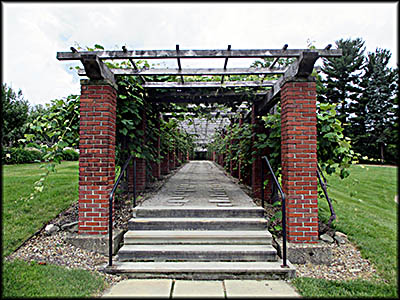


English Garden
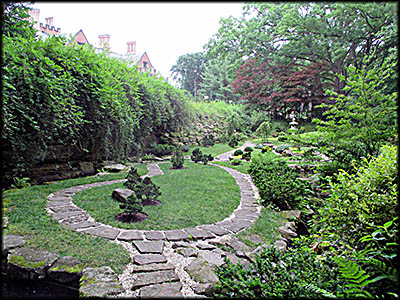

Japanese Garden
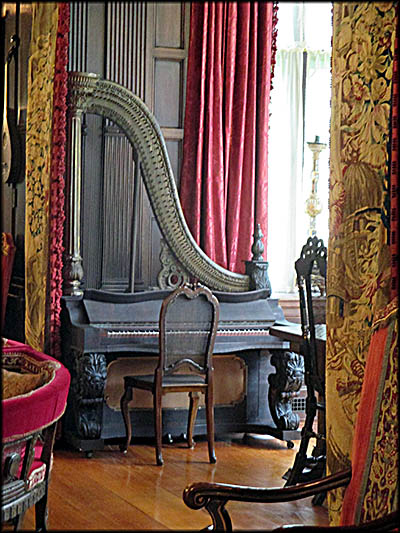
This is one of two known harp pianos in the world. Not surprisingly, it doesn't stay in tune. The other one is also in Ohio at the William McKinley Presidential Library & Museum, which the author has also visited.
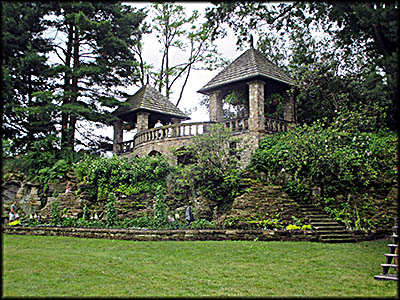
Teahouses
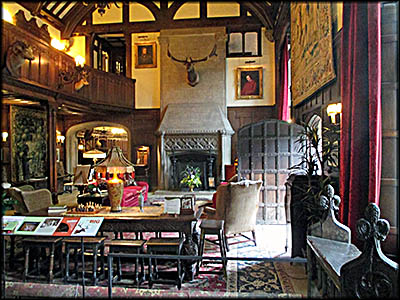
Great Hall
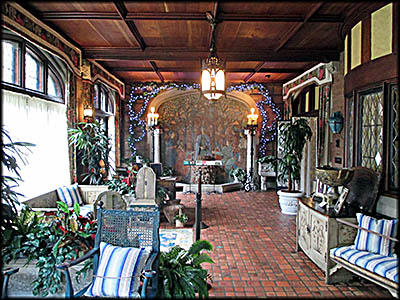
Indoor Porch
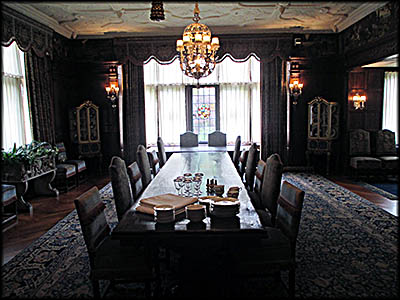
Dining Room
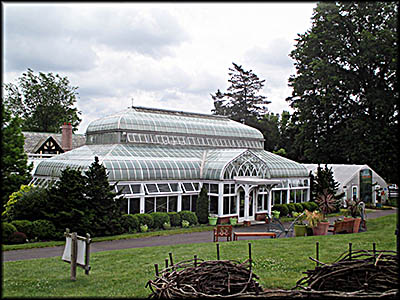
Conservatory